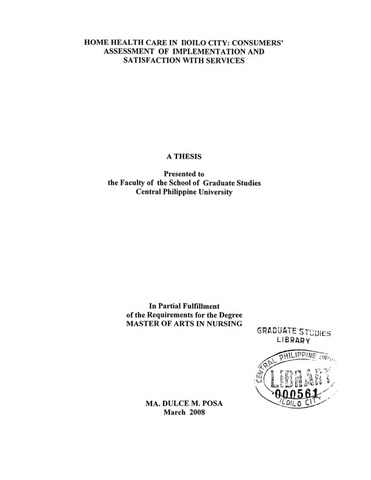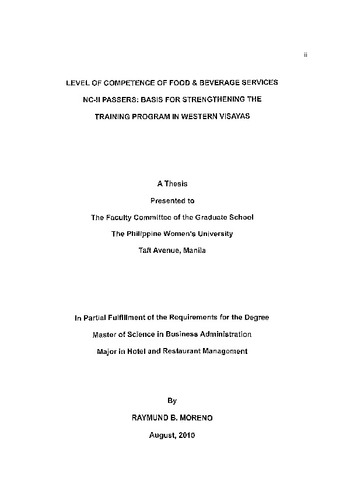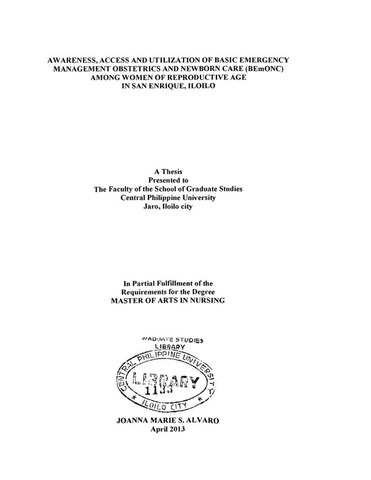Home health care in Iloilo City: Consumers' assessment of implementation and satisfaction with services

Page views
478Дата
2008Автор
Thesis Adviser
Defense Panel Chair
Share
Metadata
Показать полную информацию
Аннотации
This study is aimed to describe the home health consumer in terms of socio-demographic characteristics on terms of sex, age, civil status, family size, educational attainment and monthly income, diagnostic categories, duration of home health care service needs; types of home health care services utilized, perception of service implementation specifically its accessibility, availability and affordability and extent of satisfaction of services. Furthermore, it sought to determine if consumer’s perception of service implementation vary according to these characteristics. Likewise, the study also examined the association between consumer’s perception of service implementation and their extent of satisfaction with home health care services. This is a descriptive-associational study that utilized personal interview to collect data from 104 respondents of a selected home health care facility. A structured interview schedule was used as the survey instrument.
Major Findings
The study revealed that the majority of the 104 consumers of home health care services were living in the district of Jaro, Iloilo City, where the facility is located district of Jaro. Most of them were female, married, 52 years old on the average, and with an average family size of 4 to 6. They were mostly college graduates, working and earning between P8,000-P12,000 pesos per month. Some of them reported a monthly income of less than P4,000 pesos.
Of the 104 service users the majority had pre-existing medical condition prior to subscription to home health care services, while 37 had none. The majority of the consumers expressed that they will utilize home health care services on a long term basis (six months or more). They reported that facility offered a wide array of health care services free of charge as part of the prepaid health benefit package or at a discounted cost depending on the plan enrolled in.
Among the free services, home visit with subsequent health assessment and counseling schedule every month and 24 hour hotline services were availed of by all the Medical consultation which was conducted at the clinic, also for free was availed of by only one in every four consumers. The use of laboratory services was not also maximized, with Complete Blood Count (CBC) having been availed of by only slightly more than half of the respondents. Less than a quarter of them were able to utilize urine and stool laboratory examinations and electrocardiogram. It was markedly noted that services even free but not brought to the homes of the consumers were not availed.
The majority of the respondents perceived that home health care services was greatly accessible as services were given or utilized by consumers less than 24 hours after a service need or request is made. Most of them felt that home health care services are available at a moderate extent, that is, only half of the services prescribed from them or those that they need are available.
More than half of the respondents also felt that the cost of home health care services was lower than the cost of services in other facilities, while four in ten felt that service cost was reasonable and competitive compared to other forms of health care delivery systems of other health service providers.
The demographic characteristics of the respondents, diagnosis and duration of home health care service needs did not have a significant bearing on consumer’s perception of service availability and affordability.
Most of the service users were generally satisfied with this health care delivery system although they found areas for improvement in the service delivery. Moreover, most of them said that they would still encourage others (friends) to utilize home health care.
The consumer’s perceptions of service implementation in terms of accessibility and availability were found to be significantly associated with their extent of satisfaction with home health care services.
The relationship between consumer’s perception of service implementation in terms of affordability and extent of consumer’s satisfaction of ervices, however was not significant at 5 percent level.
Conclusions
1. Home health care services in Iloilo City, even in its infancy state is gaining ground, though slowly, among the consumers of Home Health Care services. The proximity of the facility to its consumers accounts for a high enrolment in this health service system.
2. The service-users of the home health care facility are generally elderly, female and educated. Monthly income, though not much for many was not a barrier to utilization of home health care services.
3. Pre-existing medical condition of the consumers tend to encourage enrollment to home care services. Those enrollees who did not have pre-existing medical condition apparently are prepared for future health care needs. This is affirmed by their expressed expectation to use the services for six months or more. With many of them having preexisting illnesses, it is not surprising that they expect to use service frequently.
4. The customers preference for home delivered services, despite the additional cost underscores the desire for convenience and comfort. This confirms that distance or transportation cost does not predict utilization of services since most of the consumers live within the two-kilometer radius of the facility.
5. The fact that there are still consumers who feel that the home health care facility can only partially deliver the services prescribed or desired could mean that some consumers failed to avail of some of the services of the facility or it could be service provider limitation.
6. Variations in consumer’s demographic characteristics, diagnostic categories and duration of home care service needs do not have significant bearing on their perception on the availability and affordability of services.
7. The relatively high and significant association between consumer’s perception of service accessibility and availability and their satisfaction with the services they received, indicates that it is important for the consumers to be able to receive services immediately when they need them.
8. The weak and insignificant association between consumer’s perception of service affordability and consumer’s satisfaction further affirm that cost is not a barrier of service utilization of home care services. If quality service is available when needed, service users will avail of it and most likely be satisfied, despite the cost.
9. Indeed, as King proposes, man as an open system interacts with factors that affect utilization of health care delivery system to achieve a goal. The assumption that man’s perception of service implementation in terms of accessibility, availability and affordability varies with selected consumers characteristics was rejected in this study. On the other hand, because services were perceived to be accessible and available, these results are associated with consumer’s satisfaction which is the goal of service utilization, thus, King’s goal attainment theory clearly reflects the interplay of the variables.
Описание
Abstract only
Suggested Citation
Posa, M. D. (2008). Home health care in Iloilo City: Consumers' assessment of implementation and satisfaction with services (Unpublished Master's thesis). Central Philippine University, Jaro, Iloilo City.
Type
ThesisТематика
Keywords
Department
School of Graduate StudiesDegree
Master of Arts in NursingShelf Location
GSL Theses 610.73072 P84
Physical Description
xvii, 75 leaves
Collections
Связанные элементы
Просмотр элементов, связанных по названию, автору, создателю или теме.
-
Level of competence of Food & Beverage Services NC-II passers: Basis for strengthening the training program in Western Visayas
Moreno, Raymund B. (2010)Purpose of the Study This study was conducted to assess the level of competence of Food and Beverage Services NC II passers in Western Visayas as part of ensuring that what industry wants (stated as a competency standard) ... -
Awareness, access and utilization of Basic Emergency Management Obstetrics and Newborn Care (BEmONC) among women of reproductive age in San Enrique, Iloilo
Alvaro, Joanna Marie S. (2013)Women’s utilization of maternal health care facility is an important health issue with regard to the wellbeing and survival of both the mother and her child during childbirth. There are certain factors however that inhibit ... -
Clients’ post-abortion utilization of and perceived needs from local health services of two villages in Bacolod City, Negros
Espina, Christine Renee A. (2004)Induced abortion is generally restricted in the Philippines, although it may be permitted to save the mother’s life. The stigma associated with abortion often outweighs the perceived need to seek professional medical ...





